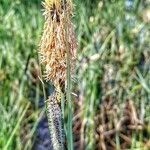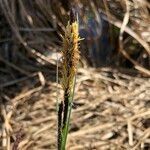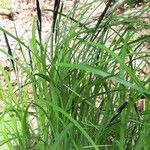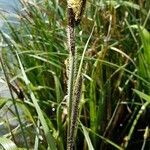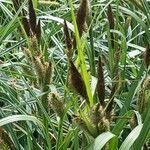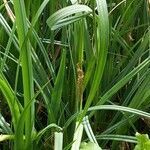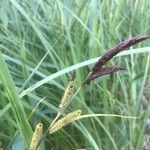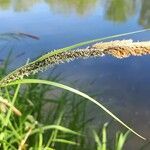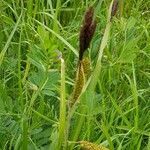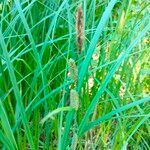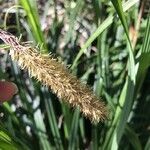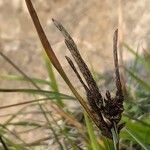Plants colonial; rhizomes long-creeping. Culms central, coarse, trigonous, 55–130 cm, scabrous-angled. Leaves: basal sheaths pale green to brownish or red tinged; ligules 5–14 mm; blades glaucous, M-shaped, (4.5–)5.5–12(–20) mm wide, glabrous. Inflorescences 15–35 cm; proximal 2–5 spikes pistillate, ascending; distal spikes erect; terminal 1–2(–3) spikes staminate. Pistillate scales lanceolate, acute to acuminate, glabrous, at least the proximal with scabrous awn to 3.5 mm. Perigynia ascending, ± glaucous, often strongly red dotted, ± strongly 12–18-veined, thin-walled, narrowly ovoid, flattened-trigonous, 3–4.5 × 1.4–2.1 mm, glabrous; beak 0.3–0.6 mm, emarginate to weakly bidentulate, teeth to 0.2 mm. 2n = 78.
Perennial herb, tufted, 0.45-0.80 m high, rhizomatous. Leaf blades up to 550 x 5-10 mm, flat or plicate. Culm nodose, sharply 3-angled, 2-3 mm in diam. Inflorescence a raceme of spikes, 130-400 mm long. Bracts 1 at each node, leaf-like. Spikes 5-7, largest 300-800 x 4-8 mm, apical 1-3 male, lowest 1-4 female. Female bracts (glumes) lanceolate, 3.0-5.5 x 0.6-1.2 mm, keel excurrent into 1.3-3.0 mm long scabrid awn. Perigynium suberect, stalked, 3-4 x 1.6-2.0 mm, 3-angled in cross section, not inflated, greyish green with whitish rostrum, cartilaginous, nervose, apex shallowly bidentate. Flowering time (Sept.) Nov., Dec. Nutlet obovate, 1.7-2.0 x 1.2-1.5 mm, 3-angled, yellowish brown, surface smooth.
A sedge. These grow in clumps and have grass like leaves and solid stalks. It develops stolons or runners. The stems are 60-120 cm high. The stems are sharply triangle shaped. They are rough along the edges. The leaves are as long as the stems. The leaf sheaths are 15 cm long. The leaf blades are 4-6 mm wide and can be flat or have their edges rolled under. Bracts extend over the flowering head. The male flower spikes are 20-40 mm long and the female spikes are 25-60 mm long. The nut is about 2 mm long by 1 mm wide.
Robust, tufted perennial, up to 0.8 m high. Rhizomes stoloniferous. Culms sharply 3-angled. Leaves glaucous, mid-green. Flowers: inflorescence a raceme of erect or suberect spikes, 130-400 mm long; female glume distinctly longer than perigynium; perigynium flattened, up to 5 mm long, with hollow papillae, conspicuously veined, rostrum apex shallowly bidentate, teeth 0.2-0.5 mm long; stigmas 3; Sep.-May.
Plants up to 0.8 m high. Caespitose with tufts connected by long rhizomes. Mature perigynia papillate, with hollow papillae, cartilaginous, conspicuously many (more than 10)-nerved. Leaves glaucous, mid-green. Inflorescence a raceme of spikes, 130-400 mm long.
Tufted perennial to 1 m. Spikelets blackish.
